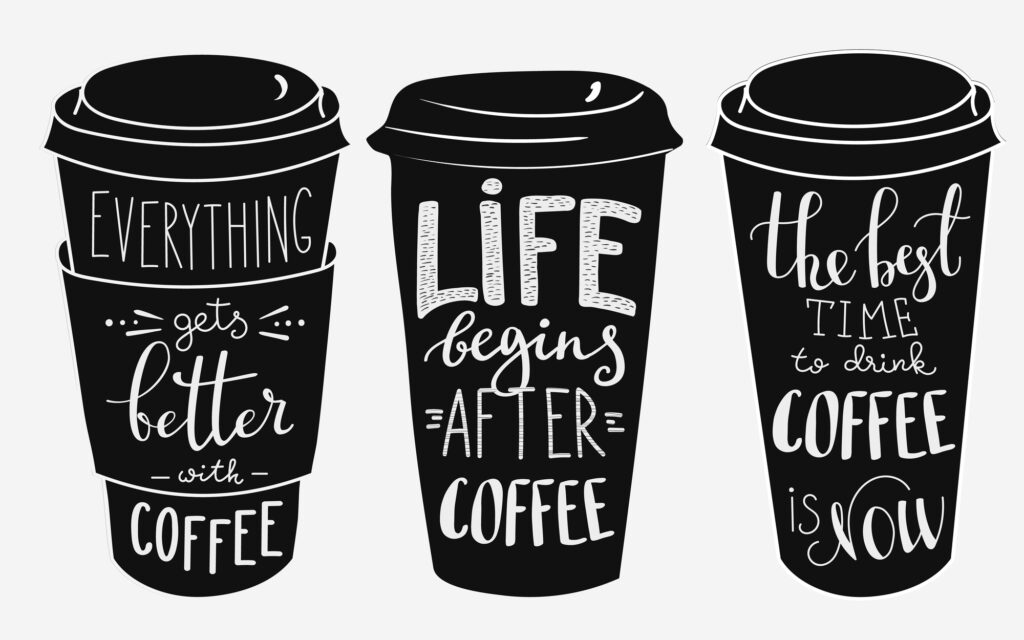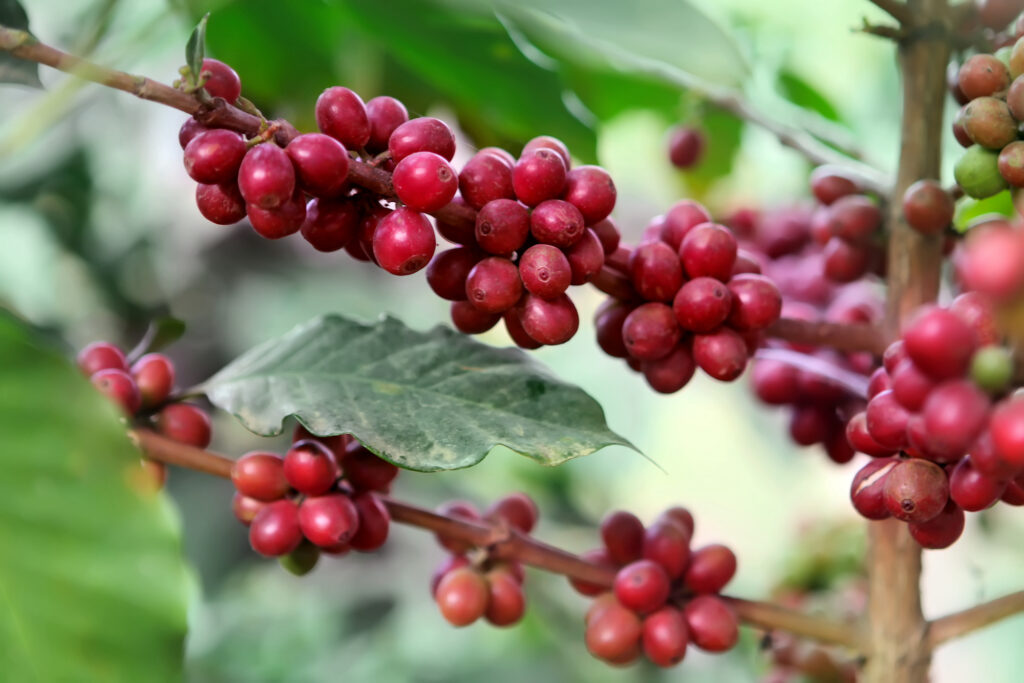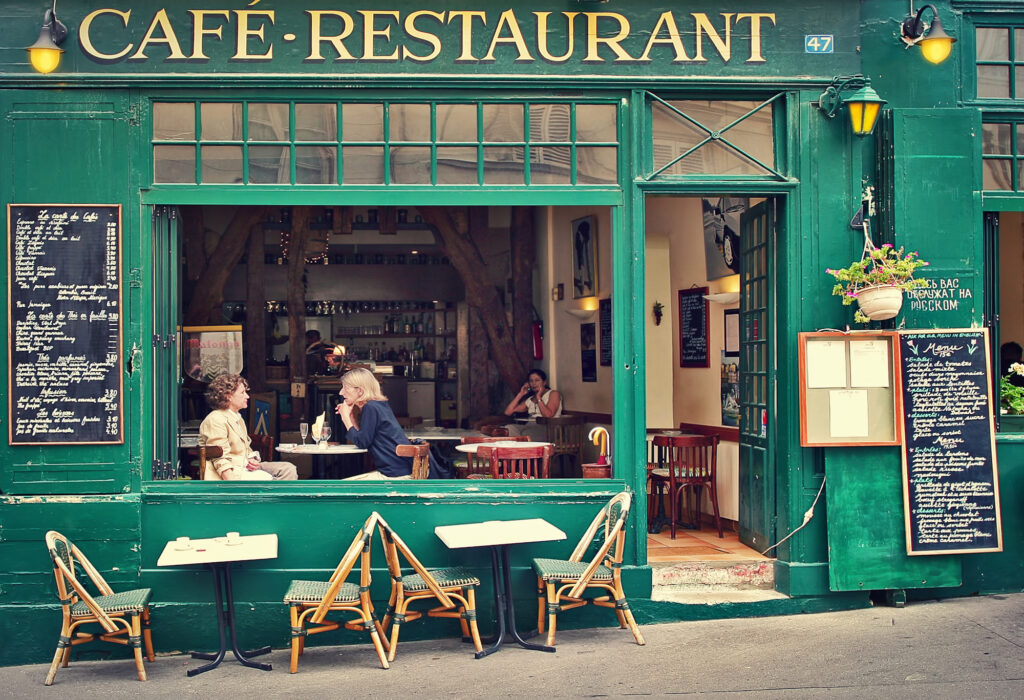Where does coffee come from – fun facts and trivia
The world of coffee is endless and can sometimes be too complicated, especially for a coffee greenhorn. But to prove to you not all coffee devotees are snobs, we put up a funny walkthrough to the most common questions about coffee. Find out what is coffee, where does it come from, and why do people like it that much!

Where does the term coffee come from?
As always, we have unclear roots on who named coffee. So, here are the two most popular theories.
The Kaffa hills
Coffee comes from Ethiopia, we got that. But in reality, it comes from the southwest of Ethiopia, where the growing conditions are perfect for ginger, cotton, corn…and coffee. That region was and still is called Kaffa, Caffa, or Kafa.
From Kaffa to coffee, the word probably changed through history, as new nations and cultures discovered the drink.
The qahva wine
The Arabs started naming the coffee qahva. It is short for qahhwat al-bun, wine of the bean. Islam is strict about alcohol usage, so Arabs enjoyed drinking coffee. The Ottomans changed qahva to kahve.
In the English language, the term coffee debuted in 1598, as chaoua. Later, we have Italian term caffe, German Kaffe, French cafe, etc.
Where does coffee come from?
At first, we got it from Ethiopia. Then, the new world got it from the old world. Nowadays, we get coffee from coffee farms in tropical countries. Here is a quick history lesson on where does coffee comes from.
Arabian roots
- The coffee origins were in Ethiopia, but it first spread to Yemen from the 13th to 15th century.
- In the 15th century, coffee spread to the Arabia region. As Islam forbids the usage of alcohol, coffee made a great substitute. Arabs also started boiling the beans, so no one else could plant the bean.
- In the 16th century, coffee spread to Egypt, Persia, Syria, and Turkey.
- The first coffeehouse opened in Constantinople (Istanbul) in 1554.
European story
At the start of the 17th century, Europe has first contact with the coffee. Several stories claimed to have an explanation, but none of them were confirmed. The most accepted version is the Ottoman slaves made the first coffee on Malta. The Catholic church declared the coffee Satan’s invention and forbade the use. However, Pope Clement VIII enjoyed the taste of the coffee and gave it official church approval.
The first European coffeehouse was opened in Italy in 1645 (allegedly). Coffee houses soon become a business and social gathering place. At first, they were reserved for rich folk, but later, every social class got access to coffee. In the centuries after, coffeehouses became the center of social life for artists, revolutionaries, and politicians.

America and teaparties
At first, Americans disliked the coffee. Captain John Smith (real name) brought the first beans to the honest settlers of Jamestown. It was the start of the 17th century, and the settlers weren’t thrilled with coffee beans. They preferred their cuppa tea. In the middle of the 17th century, coffee found its way to the settlement that is nowadays known as New York. Coffeehouses were opening, but they were not so popular. That changed in 1773 when Americans threw the world-famous Boston Tea Party. As a sign of protest against the tea tax, a lot of Americans switched to drinking coffee.
Do coffee beans come from poop?
Some of them do. You are probably thinking of the world’s famous Kopi luwak. Kopi luwak is a coffee that comes from poop. Let’s move to Indonesia and East Timor, Asia. Meet Asian palm civet, a little omnivore with an acquired taste for coffee cherries. Civets prefer to eat only the finest coffee cherries, and their metabolism alters the beans. After the beans come through the civet’s body, they are gathered, (really) thoroughly washed, and packed. A kilo of wild-collected beans can reach a price of up to $1300.
So, we have two major issues here.
The first one is about business ethics. Running up and down through the tropical forests and collecting civet poop isn’t cost-effective, so people started civet farms. Nowadays, civets are kept in small cages and fed coffee cherries by force to produce more Kopi luwak. Of course, the quality went down, as civets can’t pick the cherries anymore. One kilo of farm-made Kopi luwak costs around $100.
The main issue is…that Kopi luwak just doesn’t taste that good. The SCAA gave the Kopi luwak one of the lowest grades ever, as it lacks flavor and good acidity. So we have overpriced coffee that comes from poop, hurts animals, and tastes like poop. Why do people still drink Kopi luwak?
It’s the exclusivity and media hype that sells. Kopi luwak is for people that like to brag about the price of their cup of Joe, not the taste of it. Shame.
The newest poop coffee trend is called Black Ivory. It’s made from beans consumed by the elephants. Why do people like drinking poop coffee? But, this time, the animals are not caged. An elephant refuge in northern Thailand produces this coffee, which costs around $1500 per pound.

Why do Americans call coffee Joe?
A cup of Joe is the usual term for our coffee. But, have you ever wondered where did it all start? As always, there is more than one theory, and they are all unconfirmed, so pick the one you prefer the most.
It’s a navy thing
Meet Joseph Daniels, a Navy secretary and an author of the notorious Order 99. In 1913, Joseph ordered a total and absolute prohibition of alcohol in the Navy. Yes, the sailors weren’t even allowed the daily glass of wine or rum. The strongest drink available was…coffee. So, they started calling it a cup of Joseph, which later became a cup of Joe.
It’s a wordsmith thing
Mocha was a nickname for the coffee, as the best (and sometimes only) beans came from Mocha, Yemen. Later, Java became the synonym for the coffee, named after the island where the Dutch planted the beans. Java plus Moche equals Jamoche. Sounds weird today, but it was common slang for coffee in the 1930s. A cup of Jamoche was probably shortened to a cup of Joe.
It’s the Martinson thing
New York, a sunny day in 1898. Joe Martinson founded the Martinson coffee that quickly became popular. Joe was funny, well-mannered, and had such a great personality that all his customers adored him. So, they started ordering a cup of Joe’s drink. As Martinson’s coffee grew in popularity, so did the term expanded.
It’s an army thing
The roots of the first instant coffee in America were around World War 1. American troops serving overseas were getting instant coffee as part of their meals. The company producing that coffee was called George Washington Coffee Refining Company.
The brave American soldiers got used to drinking a cup of George every day. And when they got home, they brought their coffee drinking habits, as well as the new slang along.
It’s a common Joe thing
You know that friendly guy next door, that silent, average working man. Well, the slang for him is ‘common Joe’. And common working people were people of habits. They got up early, worked hard, and ate their meal, and drank their coffee in the diner restaurants. The black coffee was almost the trademark of the working class. And it was referred to as the cup of Joe.
Is coffee OK to drink every day?
Not just OK, but highly recommended. Of course, we are talking about black or nitro coffee without creamer or sugars. As coffee is full of antioxidants, it will make you feel and look younger. Also, coffee protects you from liver diseases, type 2 diabetes, cholesterol, and many other things trying to harm you. A cup of coffee every day will lower your risk of getting dementia, Alzheimer’s, and Parkison’s disease by up to 65%.
Coffee is full of benefits, but you should limit your daily intake. Too much coffee can disturb your sleeping schedule and make you feel disoriented and dizzy. Also, the FDA recommends limiting your daily caffeine intake to a maximum of 400 mg.
Did Vikings drink coffee?
Hardly. Vikings were at their peak from 790 to cca 1070. At that time, coffee as a drink didn’t exist. The coffee plant was domesticated 1000 AD by Arab traders, but it’s almost impossible that Vikings had a chance to encounter a ship full of coffee. The Vikings roamed in parts of northern and eastern Europe, Canada, and Greenland. They had no job whatsoever to reach the coasts of Africa. Also, coffee as a drink became popular in the 13-14th century, when Vikings were gone a long time ago. Perhaps, it’s for the best. Imagine berserk Vikings, full of caffeine and ready to pillage and loot. They have done more than enough damage by just drinking beer and mead.

How long does it take for a coffee plant to grow?
For a coffee plant to start flowering, it will take a whole year. After the flowering, it can take up to three years for a coffee plant to start maturing. The coffee plant can produce coffee cherries for the next 50 to 60 years. The first couple of decades are the most important because that’s when the beans possess the most quality.
Which country has the best baristas?
To answer that, we need to look at the World Barista Championship stats. The World Barista Championship (WBC) takes place every year since 2000. And the country with the most titles, and best baristas, is Denmark. Danish baristas won the WBC championship four times, in 2001, 2002, 2005, and 2006.
The last champion (2019) was Jooyeon Jeon from South Korea. Due to the pandemic, the WBC 2020 wasn’t held.
Which country produces the most coffee?
It’s Brazil, and it holds first place for more than 150 years. In 2016, the hardworking Brazilian farmers produced 5,714,381,000 pounds (or 2,592,000 metric tons) of coffee. The nearest competitor, Vietnam, produced 2,1 billion pounds less for the same year.
The Brazilian climate is perfect for coffee growing, especially in the southeastern part of the country. Parana, Sao Paulo, and Minas Gerais are Brasilian states with most of the coffee farms. In Brasil, coffee farms and plantations cover the surface of 27.000 square kilometers. To get the picture, 50 countries in the world have less surface than 27.000 square kilometers. So, the fact that Brasil produces about 33% of the world’s coffee isn’t that surprising.
Brazil also takes great pride in coffee processing, as most of the Brazilian coffee is produced using a dry process. Meaning, they let the coffee cherries dry in the sun instead of washing them.
Which European country has the best coffee?
This is a hard one. When you travel to Europe the first time, you will notice a few things:
- You can also get a Starbucks and McCafe in Europe
- Every country has a special coffee culture
- Almost no one drinks drip coffee
If you visit Scandinavia, you’ll be among the people that consume the most coffee in the world. They drink a variation of Turkish coffee, sometimes with added eggs(!) or vodka. In southeastern Europe, you can get Turkish, Bosnian, or Serbian coffee at people’s homes. In the bars, people usually drink espressos. Pay a visit to Italy, home of the espressos, cappuccinos, cafe lattes, and many other drinks. French and Italy are also espresso-based, like most of Western Europe.
Every country has its traditions, way of preparing, serving, and roasting coffee. Although coffee didn’t start in Europe, nor it can grow in Europe, it’s the place to drink perhaps the best coffee in the world. It just depends on which way of preparing coffee you prefer.
If you want to drink a truly good cup of joe, avoid the tourist trap bars and find small cafes where locals drink their morning coffee.

Which country has the most cafes?
The sunny and poor European country of Albania. No, it’s not a joke. Albania scrapes the bottom of many lists, including life quality, income, income per capita, dental and mental health…we could go on for hours. But according to the 2016 survey, Albania has 654 coffee houses (or bars) per 100.000 people. To put it simply, it’s one bar per 152 people. Albania took first place from Spain, which had 592 bars per 100.000 people. However, the late economic crisis closed a lot of bars in Spain and opened a lot more in Albania.
Cyprus has cca 470 bars per 100.000 people, while Italy has around 250 bars per 100.000 people.
What is the coffee capital of the world?
Let’s take a flight to Vienna, Austria. Vienna proudly bears the title of the coffee capital of the world. Even UNESCO admitted it, and since 2011, the Vienesse coffee houses are intangible cultural heritage.
Vienesse coffee houses were always a place for artists, noblemen, and common people to gather. The guests could enjoy not just the coffee, but the famous Austrian cakes, pastry, and finger food. In the evenings, it’s not uncommon to hear a piano playing.
Vienesse coffee house culture influenced the whole of Europe, but the core remained in Austria and some parts of Italy. If you happen to be in Vienna, order a Melange, Kapuziner, or Einspanner, the famous coffee drinks with milk and cream.
How did Vienna become the coffee capital of the world?
It was 1683, and the Turks were trying to conquer Vienna, again. And they failed, again. During the retreat, they left a large number of goods behind, as they were running for their lives. The Austrian army found a lot of tents, cattle, food, luxury items…and cca 500 large bags full of coffee beans. As the Austrians weren’t familiar with coffee before, they made a logical presumption it’s food for camels and wanted to simply throw it in the Danube river.
And now, let’s meet Kolschitzky, an Austrian spy who spent years among the Turks and knew the value of the coffee. Kolschitzky requested the coffee bags as his payment for the spying services he provided. After that, logically, he opened the first public place to drink coffee. It wasn’t a coffee house, it was a large tent. But, well, we all gotta start from somewhere. Viennese people enjoyed the new tasty beverage and thus the golden era of Austrian coffeehouses started.
Can I grow a coffee plant in my house?
Sure, why not? The coffee plant will make a great addition to your home garden. As coffee usually grows in tropical climates, we suggest you plant it indoors if you live outside of the coffee belt. Of course, you can always grow it in a greenhouse, but let us focus on growing the plant indoors.
Coffee plants need indirect sunlight, so it’s best to locate the pot near the window, not on the window. As coffee is a tropical plant, the temperature shouldn’t fall below 65 F. The soil in the pot needs to be moist but not too moist. Also, the pot needs to have a decent drainage system. Every couple of months, you should treat your coffee plant with a bit of fertilizer.
If you make your coffee plant happy, it can grow up to 6 feet. After the plant reaches its maturity (3 to 5 years), you might be pleasantly surprised with the flowers. And, if you pollinate those flowers by hand, you can even pick a few coffee cherries. It might not be enough for a pot of coffee, but it will give you bragging rights in the neighborhood.
What is the world’s best coffee?
The best coffee in the world is just your subjective experience and nothing more. You could spend a small fortune on a Kopi luwak, and you might not still like it. Fresh coffee is the best coffee, and there is no point in arguing further. But, a couple of other conditions determine your coffee tasting experience:
- Your current mood – stress alters the flavor receptors in your brain.
- The tongue almighty – your taste receptors can be altered depending on your diet and medication plan.
- Genetics also plays a significant role in perceiving the flavors.
- Training your tastebuds – just like with wine, cheese, or craft beer, you can train yourself to identify the coffee nuances better.
So, a high price won’t guarantee your drinking experience to be fascinating. That teenage influencer struggling to pronounce the name of the sponsor won’t guarantee you anything. Trust your nose, your palate, and the packaging date of your coffee.
Who drinks the most coffee in the world?
You would probably say Americans, right? With Dunkin Donuts, Starbucks, and McCafe on every corner, who could blame you. The answer will probably surprise you. It’s the snowy, cold country of Finland, Europe. The Finns drink cca 26.5 lbs of coffee per capita every year. Their weapon of choice is a light roast of coffee and fine grind. The traditional Finnish coffee is a variation of Turkish coffee.
Well, America is in the top three, right? Nope. The USA takes 25th place, with an average of 9,26 lb per capita. The first nine countries are all European. Canada is 10th with 14.33 lb of coffee per capita. Brazil is 14th, Lebanon is 21th. The rest of the places on this chart are taken by European countries.
This shouldn’t surprise you, as the coffee culture has been centuries in Europe, with various traditions that differ from one country to another.







